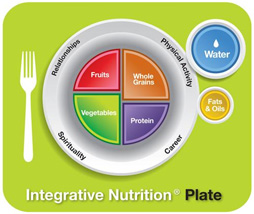 The Integrative Nutrition® Plate is adapted from the USDA’s MyPlate nutrition guidelines and emphasizes the importance of local and organic produce, whole grains, high-quality proteins, plant-based fats, and water. It provides an intuitive representation of how people eat and emphasizes the importance of proportions and portion size.
The Integrative Nutrition® Plate is adapted from the USDA’s MyPlate nutrition guidelines and emphasizes the importance of local and organic produce, whole grains, high-quality proteins, plant-based fats, and water. It provides an intuitive representation of how people eat and emphasizes the importance of proportions and portion size.
The Integrative Nutrition® Plate serves as a general guideline for healthy eating but should be adapted and customized according to what works best for you. Just as there’s no one-size-fits-all diet, there are no strict instructions on how everyone has to eat all the time.
Fruits
Eat in season, choose local and organic when possible, and eat a variety of colors. Enjoy fruit when craving sweets and snacks. In fact, add a few walnuts, almonds or almond butter to your fruit and the protein and fat will slow down the fructose absorption and keep you satisfied longer.
Vegetables
Vegetables are nutritionally rich – so fill your plate! Go for many colors, choosing dark leafy greens as much as possible. Go for local and organic when possible, especially of those vegetables on the Dirty Dozen™ list.
Whole Grains
Whole grains provide many nutrients and fiber. Avoid refined grains like white bread, white rice, and white flour products. When a breakfast cereals says “made with whole grains,” there are no whole grains left in the box. A grain is whole if you can see the whole, unadulterated grain. If you cannot digest grains or choose not to eat them, perhaps you’d do better with more veggies instead!
Protein
Choose healthy varieties such as beans, nuts, eggs, fish, and poultry. Choose organic and cage-free whenever possible. If you eat meat, choose grass-fed, organic for best quality. Avoid processed meats like bacon and cold cuts.
Fats and Oils
Use plant-based oils like olive oil for cooking and as dressing on salad. Choose wild fish, avocados, nuts, and seeds. Balance your intake of animal-based saturated fats like butter, cream, and cheese. Consider small amounts of Coconut Oil which, even as a saturated fat, has zero cholesterol. Avoid trans fats.
Water
Opt for water as your drink of choice. Limit caffeinated drinks and avoid sugary drinks completely. If you drink dairy, quality is key – choose milk free of added hormones and buy local, organic when possible.
Primary Food
To complete the picture, the plate is surrounded with lifestyle factors that create optimal health – relationships, career, physical activity, and spirituality. We call these elements Primary Food because they’re often more important than the food that’s on your plate.
- Relationships: Being well connected with others is an essential part of life, and the quality of our relationships explains a lot about the quality of our health.
- Career: Work is a huge part of our daily routine, yet how many of us really enjoy it? Finding work you love is essential to living a healthy, balanced life at any age.
- Physical Activity: Our bodies thrive on movement, and quickly degenerate without it. It’s important to find a routine that can nourish you on a regular basis.
- Spirituality: Spirituality can feed us on a very deep level and dramatically diminish our cravings for superficial rewards of life.
Integrative Nutrition encourages people to look at these aspects of life as a form of nutrition, a way to feed themselves at a much deeper level than food. The food you eat plays a critical role in your health and happiness, but the four forms of primary food make your life extraordinary.
The Integrative Nutrition® Plate is ©2013 Integrative Nutrition (Used with Permission). Material adapted from the IIN® approach to USDA good eating guidelines.


No comments yet.